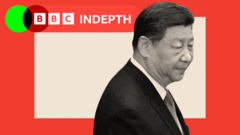As President Xi Jinping confronts rising domestic challenges amidst ongoing trade tensions with the United States, China’s economy shows signs of strain. From a collapsing housing market to stagnant consumer confidence, the future of China's financial landscape is at a critical crossroads. How these challenges interplay with external tariffs enacted by former President Trump will shape not only economic policy but the political stability of Xi's leadership.
Xi Jinping's Economic Challenge: Navigating Domestic Struggles Amid Trump's Tariffs

Xi Jinping's Economic Challenge: Navigating Domestic Struggles Amid Trump's Tariffs
China's leader faces internal unrest as economic forecasts dim and external trade tensions escalate.
China's vast market is experiencing an unusual faintness in consumer spending, largely due to the aftermath of a housing crisis that has left many citizens wary of financial stability. While Xi projects confidence with statements heralding self-reliance and hard work, the fears around housing investments collapsing and job prospects for the younger population loom large. Estimates suggest that China's housing market has faced a drastic decline, with entire cities full of empty developments symbolizing a breakdown in consumer trust.
This structural failure didn't come from external factors alone; rather, it stems from years of overbuilding and a lack of demand that has left countless homes unoccupied and millions of families anxious about their future. The next decade will see a massive generational shift, with a critical portion of the population entering retirement without adequate social security provisions, prompting concerns over potential protests due to economic discontent. Experts predict a growing disconnect between government policies and the everyday issues impacting citizens' lives.
Amid these domestic challenges, President Xi faces an imperative to stabilize the economy while dealing with the external pressures brought about by tariffs. The US tariffs imposed during Trump’s administration deflate hopes for rapid economic recovery, validating the assertion that domestic policies must rapidly adapt to shift the focus from export reliance to nurturing internal demand. Yet, efforts to stimulate the economy, such as increasing childcare subsidies and boosting local consumption, may be insufficient against the looming specter of job insecurity.
While China seeks new markets in regions like Southeast Asia and Africa to diversify trade relationships, there arises a concern that increased Chinese exports could flood into neighboring economies, inciting fears of dumping that may harm both local manufacturers and regional trade relations. Xi's diplomatic overtures must tread carefully, countering the U.S. narrative while simultaneously overcoming past tensions that might keep allied nations at bay.
In this evolving landscape, Xi Jinping’s challenge lies in transforming economic adversity into opportunity, ensuring that China can navigate the intricacies of both domestic dissatisfaction and external pressure. The outcomes of these efforts will resonate deeply in China's socio-political fabric, testing not only the strength of Xi's leadership but the loyalty of its citizenry in the face of economic uncertainty.
This structural failure didn't come from external factors alone; rather, it stems from years of overbuilding and a lack of demand that has left countless homes unoccupied and millions of families anxious about their future. The next decade will see a massive generational shift, with a critical portion of the population entering retirement without adequate social security provisions, prompting concerns over potential protests due to economic discontent. Experts predict a growing disconnect between government policies and the everyday issues impacting citizens' lives.
Amid these domestic challenges, President Xi faces an imperative to stabilize the economy while dealing with the external pressures brought about by tariffs. The US tariffs imposed during Trump’s administration deflate hopes for rapid economic recovery, validating the assertion that domestic policies must rapidly adapt to shift the focus from export reliance to nurturing internal demand. Yet, efforts to stimulate the economy, such as increasing childcare subsidies and boosting local consumption, may be insufficient against the looming specter of job insecurity.
While China seeks new markets in regions like Southeast Asia and Africa to diversify trade relationships, there arises a concern that increased Chinese exports could flood into neighboring economies, inciting fears of dumping that may harm both local manufacturers and regional trade relations. Xi's diplomatic overtures must tread carefully, countering the U.S. narrative while simultaneously overcoming past tensions that might keep allied nations at bay.
In this evolving landscape, Xi Jinping’s challenge lies in transforming economic adversity into opportunity, ensuring that China can navigate the intricacies of both domestic dissatisfaction and external pressure. The outcomes of these efforts will resonate deeply in China's socio-political fabric, testing not only the strength of Xi's leadership but the loyalty of its citizenry in the face of economic uncertainty.





















